OIF Launches New Project to Identify APIs for Transport SDN
Close on the heels of the joint Optical Internetworking Forum (OIF) and Open Networking Foundation (ONF) Global Transport SDN demonstration that concluded in October, the OIF has launched a new project to develop implementation agreements (IAs) for the application programming interfaces (APIs) used between application and network controller during the event. The new initiative will build on the Service Request and Topology APIs prototyped in the demonstration, culminating in IAs for use by carriers and equipment vendors. The new initiative will also create IAs for Service Request, Path Computation, Topology and Link Resource Manager interfaces that have been identified as part of the OIF’s upcoming SDN Framework document. The APIs to be delivered by the new project are based on REST and JSON principles enabling rapid and flexible application development.
“The prototype Transport SDN demonstration revealed a lack of definition for how user applications interact with transport network applications and resource functions,” said Jonathan Sadler, of Coriant and the OIF technical committee vice chair. “The programmability of Transport SDN requires some of the internal interfaces used by ASON to become open.”
In particular, a Service API is important as it allows applications to request connectivity services from the network. Having a common Service API allows a variety of applications to access services provided by the network, particularly in an environment with multiple domains with potentially different underlying control methods.
During the Global Transport SDN demonstration, different domains supported a number of South-Bound Interfaces (SBIs) with the Domain controller, including vendor-specific, standard OpenFlow version 1.3, and OpenFlow with optical extensions. The use of a common Service API allowed the same application to be tested across these heterogeneous domains.
Similarly, the Topology API allows applications to understand the connectivity available in the network. A common Topology API allows a variety of applications to access network topology information, enabling support for new constraints and service criteria.
The Global Transport SDN demonstration implemented a prototype Topology API. Different domains exported their topology information enabling path computation to be performed outside of the controller. These paths could then be requested using the Service API. Additionally, the Service API responses had references to links and nodes in the topology, enabling the activated path to be shown.
Leadership Elections
The Forum conducted its annual leadership election with Doug Zuckerman of Applied Communication Sciences and Junjie Li with China Telecom elected to the OIF board of directors for one-year terms. Officers re-elected to two-year terms include Dave Brown of Alcatel-Lucent, vice president of marketing; Dave Stauffer, of Kandou Bus, secretary/treasurer; John McDonough, NEC Corp of America, vice president; and Torsten Wuth, of Coriant, Physical Layer User Group working group chair.
About the OIF
Launched in 1998, the OIF is the first industry group to unite representatives from data and optical networking disciplines, including many of the world’s leading carriers, component manufacturers and system vendors. The OIF promotes the development and deployment of interoperable networking solutions and services through the creation of Implementation Agreements (IAs) for optical, interconnect, network processing, component and networking systems technologies. The OIF actively supports and extends the work of standards bodies and industry forums with the goal of promoting worldwide compatibility of optical internetworking products. Information on the OIF can be found at http://www.oiforum.com.

